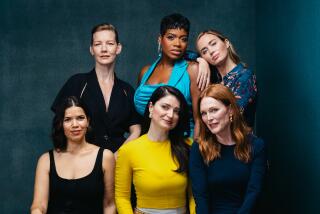Playing to type to make it in Hollywood
The class assignment in the bright, spare room of a West L.A. casting studio is simple: Turn to the stranger next to you. Then write down everything that comes to mind.
“If somebody is ugly, write ‘ugly.’ You do not do anybody a favor if you are kind,” Keith Johnson tells the students as they study one another and begin scribbling down adjectives. “If I look like a buttered popcorn-eating child molester, you know what? Cop shows need them every week!”
Being stripped down to a first impression is both tantalizing and terrifying. But for the actors in this class, who are already at the mercy of others glancing over their head shots, the exercise is empowering. The words jotted on those cards could map out a Hollywood career: Hunk. Hippie. Cougar. Druggie.
PHOTOS: Celebrities by The Times
Week by week, the students use those blunt words to help them pin down the one thing they do better than anyone else just by walking into a room — their “bull’s-eye,” says Bonnie Gillespie, who created the class. The actors then rehearse pitches, a sort of human commercial, as practice for that moment when someone in the industry asks, “So tell me about yourself.”
“I’m a tempestuous tomboy, fiery and wild,” Cait Mathis, a whirling dervish of inky hair, pink neon and black leather, tells her fellow actors. “Hanging out with me is like getting blackout drunk.... I put the hot in hot mess.”
Mathis, after a year of work in and out of formal classes, discovered that the poise she learned as a debutante can come off as “bitchy” to strangers, that the pain in her past follows her like a fragrance, that her intensity can seem, well, a bit crazy. Even outside this class, she’s handed out cards to strangers and told them to write down what they see — “bad girl,” for instance.
Gillespie, an author, casting director and self-described sherpa to creative people navigating their careers, coaches her students to hone a brand that oozes through everything they do, from the answers they give at an audition to the drink they order at a bar. Even in the grocery line or Starbucks, she urges actors to dress the part and market themselves as the nerd or the babe or the Eastern European spy. She calls it “living on brand.”
“I roll around my house in sweats, but I go to the gym in black leggings and a black tank top,” says Amber Plaster, a slim redhead with a curling smile whose brand spans “smart bitch” and “nerd fantasy girl.”
She would never wear a yellow sundress out — too innocent, she says. And unless someone asks, she’s unlikely to mention she’s from the South. It’s just not on brand. During her pitch, she tosses out this zinger: “If there were a zombie apocalypse, you’d want me on your team.”
PHOTOS: Hollywood Backlot moments
Beyond these walls, “typecasting” gets a bad rap, a death knell for the actor yearning to stretch from one extreme to the next. But as Gillespie puts it, “The second half of that word is ‘cast.’”
Los Angeles is “full of people who are really talented,” says Gillespie, who teaches the class with the help of her husband, Johnson, and other facilitators. “We don’t want people who can do everything. We want someone who does one thing really, really well.”
Classes like Gillespie’s are part of the quest for an edge in an intensely competitive industry. Though Hollywood is already crowded with advice for actors — the casting website Backstage advertises more than 900 classes and coaches on both coasts — branding or type is a niche promoted by a diverse set of teachers.
In North Hollywood, Sam Christensen, a former casting director turned consultant, guides students to develop the vocabulary to talk comfortably about what makes them unique, using adjectives checked off work sheets by fellow students, their own reflections, even the words jotted in old yearbooks and greeting cards.
“You all have this miracle of identity,” Christensen tells his class one February night. “We’re not going to do anything to change it, to make it more presentable — we’re going to facilitate it.”
Gillespie, who makes her branding advice available in free podcasts and online columns, charges $500 for her five weekly sessions, which includes extra help outside class. Other Los Angeles instructors, each with their own take on the idea, from branding tailored for voice-over actors to finding your comedic type, offer classes that can cost as much as $700.
But the strategy has its skeptics, including some of the casting directors that Los Angeles actors are trying to woo.
PHOTOS: Celebrities by The Times
“Anything that gives an actor confidence can be worthwhile,” says Sharon Bialy, who wrote “How to Audition on Camera” and casts roles for “Breaking Bad” and “The Walking Dead.” “But my concern is that the industry tends to typecast people so much. If I was ‘branding’ actors all the time, I would never cast the dad from ‘Malcolm in the Middle’ as Walter White.”
It “seems a little bit too forced and formulaic,” adds Brad Gilmore, who helped cast the TV show “The Closer” and now focuses on independent films. “It’s a weird concept to me.”
Gillespie isn’t fazed by the criticism. Once actors make a name for themselves off their bull’s-eye, she says, the industry will let them branch out — or they’ll have the money to produce something different themselves.
Skeptics, she adds, may not realize how ingrained branding is in their casting already. A cherished actor such as Robert De Niro is so thoroughly branded that the work behind it is invisible.
“Why wouldn’t you want to capitalize on what you bring to the table, right off the bat?” asks Sunday Boling, who mainly casts independent films. “If you’re 6-foot-5, it’d be a shame to say, ‘I don’t want to play any basketball roles.’ You nail something over and over again, and the casting director will call you in for something else.”
Still, branding can also raise fears of playing into harmful stereotypes. J. Blakemore, a black actor who did a typing exercise run by someone else, felt troubled by getting back words such as “urban” and “scary.” He was typed as a likely gang leader, drug dealer or police officer.
It’s a hazard that Christensen is candid about.
“Some actors who come to me are PhD students, yet because they happen to be Latino, they get called in as gangbangers,” he says. “One Asian American actor tells me, ‘I cannot add two and two. But everybody wants to make me the math professor.’”
PHOTOS: Arts and culture in pictures by The Times
But knowing what makes you distinct, he says, can actually be a way out of thin, stereotyped roles. Since the jobs are there, “you show them what kind of math professor would you be,” by bringing something authentic about yourself to that type, Christensen says. “That’s the best way to crack the box. We’re not going to crack it by holding up signs.”
Back in Gillespie’s class, students practice their pitches.
“I was homecoming queen, president of my sorority,” a lipsticked blond tells the room, tossing her hair. “I live my life by the motto, ‘When in doubt, go out.’”
“I’m your all-American, normal guy,” a man with an ordinary Joe-exterior says. “I work as a shift supervisor down at the plant. I always say, ‘A bad day of fishing is better than a good day at work.’”
Of course, their pitches don’t reflect everything these actors are. The blond is smart. The average guy is an aerospace engineer, something Gillespie later says she wishes he’d folded in. The more unique the brand, the better.
Still, Johnson reminds the students as they “brandprov” in response to questions from their classmates — “What’s in your purse?” “What’s your favorite TV show?” — “the correct answer is not the honest answer, it’s the spun answer.”
PHOTOS: Real places, fictional characters
Sharon Sharth, a seasoned actress with a megawatt smile, a torrent of curIs and a stack of cards calling her “sensuous,” “New Age” and “upscale,” confesses to the class that she isn’t quite sure of her brand. Her fellow students start tossing out suggestions.
“I see you as this hot, sexy type of person — with the martini lunches, like Samantha Jones” from “Sex and the City,” one student muses.
“I feel like she’d do yoga on a yacht,” another adds.
True to brand, Sharth later plays a gorgeous, successful middle-aged woman whose refrigerator is checkered with photos of past romances in a production at the Odyssey Theatre Ensemble. She credits Gillespie with helping her learn how others see her. “I felt more comfortable doing [the part],” she says.
For Mathis, it took a while to fully embrace her brand, particularly the darkness that people saw in her. There is pain in her past — “I’ve experienced a lot of death for someone as young as myself,” she says simply — and she thought sarcasm had masked that pain. She hated the quip “puts the hot in hot mess” when another actor first suggested it. She now embraces the term “bitch.”
“Bonnie is a genius,” Mathis says. “She’s empowering actors.”
Ultimately, branding is a business strategy. When actors learn how Hollywood sees them, “a lot of times people want to say, ‘I’m much more than that,’” Johnson tells the students. “But the industry doesn’t care.”
“You can fight it and get incredibly frustrated or embrace it and find out what makes you unique and different and capitalize on that,” says Bob Clendenin, a friendly dad who has made a career playing “deranged security guards, weird bureaucrats, postal workers, guys that live in the basement.”
Clendenin hasn’t taken a class from Gillespie, but he uses her advice and plays up his brand to get work. As he realized how he was seen by the outside world, he adapted to play up his oddball vibe. He tones down his friendly demeanor whenever he walks into an audition.
As a result, he and his family, he says, “live a nice middle-class life. I’m regularly on a TV show that keeps me busy. If I’m lucky, I do three or four national commercials a year.”
And, Clendenin adds, “to be honest, it’s so much fun to play the weird guy.”
MORE
INTERACTIVE: Christopher Hawthorne’s On the Boulevards
Depictions of violence in theater and more
PHOTOS: Arts and culture in pictures
More to Read
The biggest entertainment stories
Get our big stories about Hollywood, film, television, music, arts, culture and more right in your inbox as soon as they publish.
You may occasionally receive promotional content from the Los Angeles Times.






